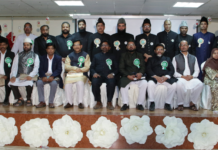Bilingualism, in many cases even multilingualism, being a special quality of most Indians, it comes as no surprise that many scholars working in various English Departments of Indian universities and colleges have produced work of considerable merit in several Indian languages. Often this work, both creative and critical, has not been sufficiently acknowledged because the English Departments in India were mostly concerned with the canonical study of English literature. The work done on the English canon and on Indian languages belonged to two different domains, with a separate group of readers.
With a drastic change in the nature of English studies in India in the last two decades or so, the broadening of the English canon following a decolonising process, the introduction of literatures in Indian languages through English translations and their inclusion in university curricula, and a renewed confidence with which to view local and indigenous traditions of literature and criticism, these two domains are beginning to converge.
Urdu literature in an English department
While taking stock of the work produced in English Department at Aligarh Muslim University on the occasion of the Azaadi ka Amrit Mahotsav celebrations, it was heartening to note that many scholars, otherwise well-known as hard-working teachers of English and sound scholars of English literature, contributed in a big way to Urdu literature and criticism. Their grounding in the Persio-Urdu literary culture and knowledge of English literary and critical traditions gave them a distinct identity, which also offered a position of advantage in many ways for approaching English literary texts.
These academics were often straddling two worlds without getting sufficient acknowledgement from either. For the western critics and academics they pretended to know what they were not fully entitled to and were hence treated with a degree of condescension, and for their counterparts in Indian languages English professors were trespassers into a territory to which they had forfeited the rights when they opted for a foreign language and literature.
Three important categories of the AMU English Department’s contribution to Urdu can be identified. First, those who joined the Department as faculty members, spending a great deal of their time in Aligarh writing in both Urdu and English. Second, members of the English Department who read in Urdu but wrote in English, either translating from Urdu to English or writing academic articles and books using Urdu sources. Third, those who studied in the Department of English but moved out to different places, doing substantial work belonging to either of the two categories: creative work, literary criticism, and translation into Urdu from English.
The association of the first two categories of people with Urdu also tells the story of the gradually changing status of the language in India. Most of the people, or rather all, belonging to the first category were born in undivided India, when Urdu had a vibrant presence in the country. The generation born before Independence also had the advantage of being familiar with Persian, which made their Urdu impeccable. The second category, born after Independence, was generally more proficient in reading Urdu than in writing in the script, and have mostly written in English.
Mapping out the work of the faculty members of English Department since independence, it emerges that a good number of them, beginning with Professor Khwaja Manzoor Hussain (1904-1986), had a substantial output of Urdu literature and literary criticism. Well-versed in English, Urdu and Persian, Khwaja Manzoor Hussain, chairman of the Department from 1946 to 1948, was a man of immense learning, much sought after for his insights into literature.
Asloob Ahmad Ansari, an eminent Urdu critic mentions in his profile of Hussain in his book Aina Khane Mein that leading Urdu writers and poets like Rasheed Ahmad Siddiqui, Firaq Gorakhpuri, Faiz Ahmad Faiz, Pitras Bukhari, Ahmad Nadeem Qasmi, Wiqar Azeem, Intizar Husain, and Shan ul Haq Haqqi have acknowledged Manzoor Hussain’s range of scholarship and critical insights into literature.
Ansari also writes that Faiz sent his famous nazm “Ye daagh daagh ujala ye shab guzida sahar” to Khwaja Manzoor Husain before its publication, and he read it in many gatherings in Aligarh. Another incident relates to English novelist EM Forster – he was a close friend of Sir Ross Masood, Sir Syed’s grandson and AMU’s vice chancellor from 1929 to 1934, and an inspiration for the character of Dr Aziz in Forster’s modern classic A Passage to India – when he was in Aligarh’s historic Union Hall Building to deliver a lecture on Charles Dickens, organised by the Raleigh Literary Society of the Department of English. Introducing the speaker, Khwaja mentioned some of the forgotten writings of Forster, which even the novelist probably did not remember. Forster remarked in wonderment, “You are slandering me”.

How world literature inspired modern writings in Urdu
A cultured, soft-spoken and self-effacing person, Khwaja did not publish much while in Aligarh, though he was known to be translating some Russian short story writers into Urdu and working on different aspects of Urdu ghazals. It was only in the late 1970s that he published his book of Urdu translations of Russian stories with a preface written by Faiz Ahmad Faiz. Ansari is of the opinion that Hussain’s translation of the stories of writers like Chekhov influenced the course of the Urdu short story significantly.
In other words, Ansari suggests that Urdu writers of short stories were made familiar with Russian greats through Hussain’s translation. Treating some difficult and controversial literary and critical issues with frankness, his book titled Iqbal aur Baaz Dusre Shayar tries to assess Iqbal’s status vis-à-vis other important Urdu and Persian poets. His longstanding interest in the genre of the ghazal, especially its relationship to contemporary social and political movements, yielded two very important books in 1970s: Tahreek Jado Jihad Bataur Mauzu-o- Sukhan and Urdu Ghazal ka Khariji Roop Bahroop. Presenting a new proposition, and receiving bouquets and brickbats in equal measure, he argued that ghazal poetry has a political and social dimension which may not be directly visible on the surface, but is very much a part of this genre.
Salamatullah Khan, another important name in this context who joined the English Department in 1945 and retired as a reader (promotions were difficult at that time), was one of the pioneers of American literature in the northern part of India at a time when American literature hardly had any presence in universities and colleges. He can be spotted in a group photograph of the delegates who met in Mussoorie in 1962, a meeting which led to the establishment of the American Studies Research Center in Hyderabad (ASRC), at one time the best resource for books and journals on American studies.
Though Khan worked on Emily Dickinson for his doctoral thesis, a lesser-known aspect of his work is the publication of his three books in Urdu titled Majaz ka Almiya aur Doosre Mazameen (1969), Amriki Adab ka Mukhtasar Jayeza (1978), and Ernest Hemingway: Hayat-o-Fan ka Tanqidi Mutaala (1980). Majaz ka Almiya includes his essays on Mir Taqi Mir, Ghalib, Sauda, Faiz Ahmad Faiz, some rebel poets of Urdu, and the genres of ‘azad nazm’ and ‘inshaiya’. His history of American literature follows the method of literary history popular at that time, introducing first the pioneers like Jonathan Edwards, Benjamin Franklin, and Thomas Jefferson, and then discussing different trends and movement in American literature. His crisp and analytical style, not a very common feature of Urdu prose, makes his book on Hemingway, which covers all his important works, a good read even today.
How Aligarh Muslim University nurtured contemporary Urdu literature
The most prolific of all academics associated with the department was undoubtedly Asloob Ahmad Ansari (1925-2016), who wrote extensively in both English and Urdu. A bilingual critic, Ansari joined the department in 1947, headed it for almost two decades, and influenced a whole generation of his students and colleagues to read closely and write carefully.
An established Shakespeare and Blake scholar, he has a huge corpus of work in Urdu, mostly literary criticism, but also sketches and memoirs, and many edited volumes. Ghalib and Iqbal were his favourite poets, but he has written on almost all important Urdu poets. His books on Ghalib include Naqsh-e-Ghalib (1970), Naqsh Hai Rang Rang (1998) and on Iqbal Iqbal ki Terah Nazmein (1977), Iqbal ki Muntakhib Nazmein and Ghazlein (1994), Iqbal Harf-o-Mani (1998). Among the many books he edited, his two-volume Ghazal Tanqeed: Vali Deccani se Iqbal aur Maabad Iqbal Tak (2002) is especially remarkable for its comprehensiveness and variety.
Though he has written more on Urdu poetry, a dominant genre in Urdu literature, Ansari’s work does cover his analysis and evaluation of all canonic Urdu novels and other genres of prose. His books Urdu ke Pandrah Novel (2003) discusses, among others, important novels like Umraojan Ada, Maidan-e-Amal, Udas Naslein, and Aag ka Dariya. His book Aitraf-e-Rasheed Ahmed Siddiqui (1977) unravels the personality and art of Rasheed Ahmad Siddiqui, a master humorist and satirist. His articles on different literary issues are included in Adab aur Tanqeed (1968) and Andazey (2008).
An excellent prose writer, Ansari has also written a delightful book of sketches, Aina Khane Mein, which includes his sketches and assessments of some of his contemporaries, such as Dr Zakir Husain, Rasheed Ahmad Siddiqui, Khwaja Manzoor Husain, Maulvi Zia Ahmad Badauni, Dr Abdul Aleem, Syed Hamid, Malik Ram, Khaleeq Ahmad Nizami, Ale Ahmad Suroor, and Mukhtaruddin Arzoo.
Ansari brought out a literary journal in Urdu, Naqdo Nazar, which provided a platform to many of his colleagues to write on a regular basis. Among his colleagues in the Department of English, Professor ZA Usmani, Zahida Zaidi, Amin Ashraf, Mohd Yasin, Maqbool Hasan Khan, S Wiqar Husain, Abdul Raheem Kidwai, and Syed Asim Ali wrote for the journal regularly, often at his persuasion. He also motivated many young scholars from other disciplines, including people like Shafey Kidwai, now a Sahitya Akademi award winner in Urdu, to write for Naqdo Nazar.
Ansari himself contributed articles, analyses of poems and book reviews to the journal on a regular basis. In fact, often the major portion of the journal comprised his own contributions. He also brought out a collection of his editorials and obituaries published in Naqdo Nazar in his book Harf-e-Chand (2005). Many of Ansari’s articles, written over a long period of time, were published in book form in his last phase, largely due to the practical help he received from his former student Abdul Raheem Kidwai.
The work of Zahida Zaidi (1930-2011), a poet, dramatist, novelist, translator and above all a liberal face of Aligarh all through her career, will surely enjoy an afterlife as more and more English translations of her Urdu plays appear on the scene. Known for nurturing the talent of Naseeruddin Shah and introducing him to many Continental playwrights, Zaidi was one of the pioneers of Urdu drama. She translated the plays of Chekhov, Pirandello, Sartre, Beckett and the poems of Eugenio Montale, Garcia Lorca, and Pablo Neruda into Urdu. Full of elaborate stage directions, her Urdu plays are heavily inspired by absurdist theatre, where often there is minimalist use of stagecraft. Departing from the technique of realism, they have, however, been inspired by many real events and topical issues.
Woh Subah Kabhi Toh Ayegi (1990) a feminist play in many ways, responds to the issue of domestic abuse. In Doosra Kamra (1990) a play in which the line between dream and reality appears blurred, all characters meet in one room while another room becomes a frightening place, with dead bodies appearing in it one by one. Jungal Jalta Raha (1990) probes the complexities of human character and Kyun Kar Us But se Rakhoon Jan Azeez (1998) laments the loss of culture and values in academic spaces.
Responding to the tragedy of the Gulf War, she wrote Sahra-e-Azam (1991), an anti-imperialist play where she is critical of American bombing in Iraq. She also responded to the tragedy of Gujarat in her play Bahut Door Tak Raat Hogi (2006) and dedicated it to “the martyrs and persecuted people of Gujarat; those persecuted women who were victims of the lust of cruel beasts; those innocent people languishing in jails for their innocence; those innocent children who are in search of their lost paradise.” Like George Bernard Shaw, Zaidi wrote long prefaces to her plays which provide a rich commentary on the context, making it easier for her readers to appreciate the technique and thematic concerns.
Zahida Zaidi’s lone novel Inquilab ka Ek Din (1996) is a campus novel, talking about one day in the life of its young female protagonist, but its canvas is wider because her use of stream of consciousness narration in certain parts of the novel. Zaidi also has seven collections of poems, two in English titled Broken Mirror (1979) and Beyond Words (1984), and five in Urdu titled Zahr-e-Hayat, Dharti Ka Lams, Sang-e-Jan, Shola-e-Jan, and Sham-e-Tanhai.







